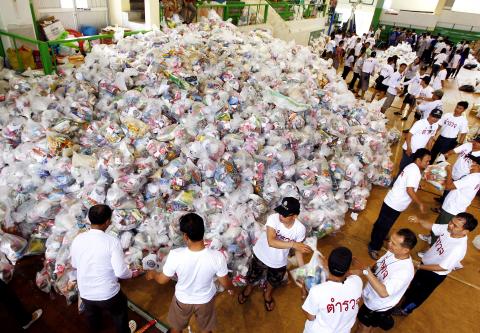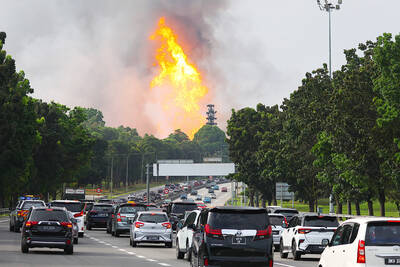Traffic clogged roads out of the Thai capital yesterday, as tens of thousands of people fled ahead of a high tide expected to worsen floods that have inundated factories and prompted foreign governments to warn their citizens to stay away.
The main concern is that Bangkok’s Chao Phraya River will burst its banks over the weekend during the unusually high tide that began yesterday. Buildings across Bangkok have been sandbagged for protection, and some vulnerable streets were nearly deserted.
Thailand’s worst flooding in half a century, caused in part by unusually heavy monsoon rain, has killed 377 people since mid-July and disrupted the lives of nearly 2.2 million, until now mostly in the north and central provinces.

Photo: EPA
TV footage showed cars and trucks bumper-to-bumper leaving the city and the main airport’s departure lounges packed, but the traffic department said it could not put an exact figure on the size of the Bangkok exodus because much of its monitoring equipment was under water.
Thai Prime Minister Yingluck Shinawatra said she was considering a proposal to dig channels into some roads in eastern Bangkok to drain water into the Gulf of Thailand, an idea backed by the chairman of the Thailand unit of Toyota Motor Corp, whose factories have been badly flooded.
“We need to look into several details on whether it works,” Yingluck told reporters.
The Meteorological Department warned residents living along the Chao Phraya they could face rising waters. Roads around the Grand Palace are partially flooded along with some streets in densely populated Chinatown.
Yesterday morning, on a street in front of the Grand Palace normally bustling with tourists, a 2m snake was caught by a motorcycle taxi driver. Residents have also had to contend with crocodiles escaping from flooded farms.
While many of the inner-city streets of Bangkok remained dry, the suburbs continued to struggle.
In the riverside shantytown of Bang Phlad, small wooden homes were knee-deep in foul-smelling water with rubbish floating on the surface. Residents carried belongings above their heads, struggling against the current of water pumped back out to the river.
At the district’s Yanhee hospital, two dozen emergency room doctors and nurses shovelled sand into sacks to fortify a 1m wall protecting the building as water levels rose in a nearby canal brimming with trash.
In Nonthaburi Province bordering Bangkok, walls of sandbags were collapsing under the weight of surging floodwaters. A policeman dressed in shorts, flip-flops and a vest directed traffic on a megaphone as water gushed out of drains.
Yingluck’s government declared a five-day holiday from Thursday to allow people to leave. Roads out of the city to the flood-free south were jammed. Many were heading for the seaside town of Hua Hin and the eastern resort city of Pattaya, where hotel rooms and homes to rent were scarce.
The economic toll continued to pile up across Thailand, Southeast Asia’s biggest auto production hub and a major base for multinational firms, many of which face supply and production disruptions after the floods shuttered at least seven huge industrial estates north of Bangkok.
The Bank of Thailand nearly halved its projection of economic growth this year to 2.6 percent from July’s 4.1 percent estimate, and said the economy would shrink by 1.9 percent sequentially in the December quarter because of the floods.
Daihatsu Motor Co, which makes mini-vehicles for Toyota Motor Corp, said it would reduce work to produce Toyota-badged cars at two Japanese factories next week due to a shortage of parts from Thailand.
However, insured losses are likely to be at a manageable level and will not trigger widespread solvency problems, credit-ratings agency Fitch Ratings said.
Many Thais are uninsured and Japanese non-life insurers in Thailand will bear the brunt of losses at the factories.
Fitch, citing Thai insurance regulatory data, estimated the country faced about 140 billion baht (US$4.5 billion) in losses, including damage at the seven industrial estates. About 80 percent of that is covered by Japanese insurers, but they are unlikely to be badly affected with about 85 percent of their coverage ceded to foreign reinsurers, Fitch said.

A fire caused by a burst gas pipe yesterday spread to several homes and sent a fireball soaring into the sky outside Malaysia’s largest city, injuring more than 100 people. The towering inferno near a gas station in Putra Heights outside Kuala Lumpur was visible for kilometers and lasted for several hours. It happened during a public holiday as Muslims, who are the majority in Malaysia, celebrate the second day of Eid al-Fitr. National oil company Petronas said the fire started at one of its gas pipelines at 8:10am and the affected pipeline was later isolated. Disaster management officials said shutting the

US Vice President J.D. Vance on Friday accused Denmark of not having done enough to protect Greenland, when he visited the strategically placed and resource-rich Danish territory coveted by US President Donald Trump. Vance made his comment during a trip to the Pituffik Space Base in northwestern Greenland, a visit viewed by Copenhagen and Nuuk as a provocation. “Our message to Denmark is very simple: You have not done a good job by the people of Greenland,” Vance told a news conference. “You have under-invested in the people of Greenland, and you have under-invested in the security architecture of this

UNREST: The authorities in Turkey arrested 13 Turkish journalists in five days, deported a BBC correspondent and on Thursday arrested a reporter from Sweden Waving flags and chanting slogans, many hundreds of thousands of anti-government demonstrators on Saturday rallied in Istanbul, Turkey, in defence of democracy after the arrest of Istanbul Mayor Ekrem Imamoglu which sparked Turkey’s worst street unrest in more than a decade. Under a cloudless blue sky, vast crowds gathered in Maltepe on the Asian side of Turkey’s biggest city on the eve of the Eid al-Fitr celebration which started yesterday, marking the end of Ramadan. Ozgur Ozel, chairman of the main opposition Republican People’s Party (CHP), which organized the rally, said there were 2.2 million people in the crowd, but

JOINT EFFORTS: The three countries have been strengthening an alliance and pressing efforts to bolster deterrence against Beijing’s assertiveness in the South China Sea The US, Japan and the Philippines on Friday staged joint naval drills to boost crisis readiness off a disputed South China Sea shoal as a Chinese military ship kept watch from a distance. The Chinese frigate attempted to get closer to the waters, where the warships and aircraft from the three allied countries were undertaking maneuvers off the Scarborough Shoal — also known as Huangyan Island (黃岩島) and claimed by Taiwan and China — in an unsettling moment but it was warned by a Philippine frigate by radio and kept away. “There was a time when they attempted to maneuver